
The Caproni Ca.3 is an Italian heavy bomber of World War I and the postwar era. It was the most produced version of the series of aircraft that began with the 1914 Caproni Ca.1 and continued until the more powerful 1917 Caproni Ca.5 variant.

The Alfa Romeo 115 is an Italian six-cylinder air-cooled inverted inline engine for aircraft use, mainly for training and light planes, based on the de Havilland Gipsy Six engine. Production totalled approximately 1,600 units. Derivatives of the 115 include the -1, bis, ter and Alfa Romeo 116.

The Fiat CR.20 was a biplane fighter designed and produced by the Italian aircraft manufacturer Fiat. It represented an intermediate step from the early biplane CR.1 and the later, successful series CR.30, CR.32 and CR.42.

The Breda Ba.25 was an Italian two-seat biplane trainer designed and built by the Breda company. It was the most widely used Italian basic trainer of the 1930s.
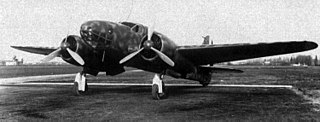
The Caproni Ca.310 Libeccio was an Italian monoplane, twin-engine reconnaissance aircraft used in World War II. Derived from the similar Ca.309, it had its combat debut during the Spanish Civil War and took part in the earlier phases of World War II in Libya. Some were used in attack groups as a temporary replacement for the unsatisfactory Breda Ba.65. The last Ca.310 was retired by the Italian Air Force in 1948.

The Caproni Bergamaschi AP.1 was an Italian monoplane attack aircraft designed by Cesare Pallavicino, coming from the Breda firm.

The Caproni Ca.135 was an Italian medium bomber designed in Bergamo in Italy by Cesare Pallavicino. It flew for the first time in 1935, and entered service with the Peruvian Air Force in 1937, and with the Regia Aeronautica in January 1938.

The Caproni Ca.111 was a long-range reconnaissance aircraft and light bomber produced in Italy during the 1930s. It was a derivative of the Ca.101.

The Caproni Ca.101 was a three-engine Italian airliner which later saw military use as a transport and bomber. It was designed in 1927 and first flown in 1928.
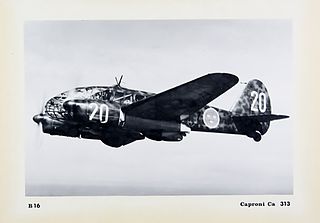
The Caproni Ca.313 was an Italian twin-engine reconnaissance bomber of the late-1930s. It was a development of the Ca.310. Its variants were exported to several other countries.

The Caproni Vizzola F.5 was an Italian fighter aircraft that was built by Caproni. It was a single-seat, low-wing cantilever monoplane with retractable landing gear.
The Piaggio P.32 was an Italian medium bomber of the late 1930s, produced by Piaggio, and designed by Giovanni Pegna. It was a modern design for its time, but was a failure due to lack of powerplants commensurate with its high wing loading.
The Caproni Ca.97 was a utility monoplane aircraft designed and produced by the Italian aircraft manufacturer Caproni. It had a range of powerplant arrangements, the aircraft could be flown with many as three radial engines, however, many were built with only the nose engine present or with only the two nacelle-mounted engines.

The Caproni Ca.113 was an advanced training biplane produced in Italy and Bulgaria in the early 1930s. Designed as a follow-on to the Ca.100, it was a more powerful and robust aircraft capable of aerobatics. It was a conventional design with two cockpits in tandem, single-bay staggered wings of equal span, and mainwheels covered by large spats.

The Caproni Ca.114 was a fighter biplane produced in Italy in the early 1930s which was flown operationally in Peru in the 1930s and 1940s.
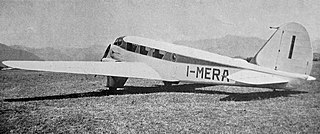
The Caproni Ca.308 Borea was a small airliner built in Italy in the mid-1930s.

The Farman F.430 was a 1930s French light transport designed and built by the Farman Aviation Works. Two variants with different engines were known as the F.431 and F.432.
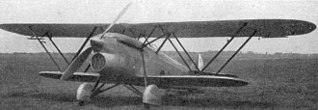
The Fiat CR.30 was a 1930s Italian single-seat biplane fighter aircraft designed by Celestino Rosatelli and built by Fiat.
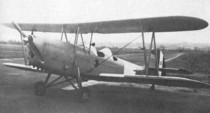
The SAIMAN 200 was a 1930s Italian two-seat primary trainer designed and built by the Società Industrie Meccaniche Aeronautiche Navali (SAIMAN).
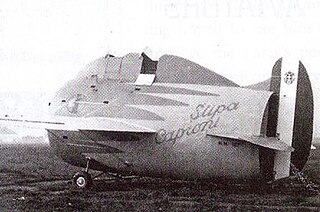
The Stipa-Caproni, also known as the Caproni Stipa, was an experimental Italian aircraft designed in 1932 by Luigi Stipa (1900–1992) and built by Caproni. It featured a hollow, barrel-shaped fuselage with the engine and propeller completely enclosed by the fuselage—in essence, the whole fuselage was a single ducted fan. Although the Regia Aeronautica was not interested in pursuing development of the Stipa-Caproni, its design influenced the development of jet propulsion.




















